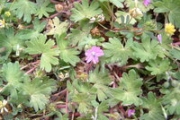Viewings: 4792

Someone global warming frustrating, and some, on the contrary, he was very glad. Scientists from the UK found that the once rare in the Islands brown Golubenko could be a butterfly only due to higher summer temperatures. She literally has broadened their horizons is mastered new territory, tried a new "kitchen".
How global warming affects the life and habits of animals and plants, hard to say. The matter is that to any living creature is important, not the average temperature on a planet, but how warm or cool in the place where it dwells (just as for us, when we go out, is not the average temperature in the city, as such, in our backyard). Well, because the local temperature change (and other parameters) is slower than the global, and besides with strong delay, it turns out that global warming most animals and plants still just didn't pay attention.
However, some of our smaller brothers warming still has helped. In particular, a beautiful butterfly - brown Golubenko (Aricia agestis), which could due to higher summer temperatures extend their range northward. However, let's do first things first.
The fact that not so long ago, brown Golubenko was widespread in continental Europe, but here in Britain it was to be found infrequently. Borders of the distribution area of this creature was held in southern England. Data 1980 talked about the fact that this animal was included only in those places where grew Solntseva monetarily (Helianthemum nummularium) - also, incidentally, a very rare plant in the British Isles. It leaves sanasuma and eating caterpillars Blues, and no longer than otherwise.
As you can see, distribution Blues North resisted not cold weather and lack of forage plants. Solntseva was rare because of the climate of Britain is a plant can't stand the cold. So it grows mainly in southern, warm hill slopes. And it was there and met the Blues until 90-ies of the last century.
However, since 1991, started to happen strange things. Brown Golubenko suddenly for no apparent reason began to rapidly expand its range in the Northern direction, settling including areas where Solntseva not growing. Entomologists were surprised because it was also thought that leaves no other plants, the caterpillars this butterflies eat can't. However, it quickly became clear that the larvae Blues began to consume soft geranium (Geranium molle), which requires less heat and can grow in cool places.
Entomologists from York University, organized a large-scale study of settlement of Blues, which was attended by experts from the Society for the protection of butterflies, as well as nature lovers, and not only young - monitoring butterflies still is one of the most favorite Hobbies Brits. The work lasted more than twenty years, but only recently, scientists were able finally to summarize all the data. In the end, it turned out interesting things - the main reason for the expansion of the range of brown Blues, apparently, was the development of a butterfly host plants, which they previously avoided and which are much broader than Solntseva.
However, the question arises - why British brown Blues had not settled on the geraniums? The authors suggested that the reason lies in climate change. Since the 90-ies of the last century, the average summer temperature in the British Isles began to grow steadily. To test their hypothesis, the scientists compared the data of observations for butterflies with the schedule of climate change in the last 200 years. It turned out that the prevalence of brown Blues on the geraniums, and the relative rate of growth "geranium" populations compared with "solncechnyj" shows a clear positive correlation with summer temperatures. And with summer, not winter and annual average.
But why is this happening? The experiments on growing of Blues in captivity has shown that in fact their caterpillars can eat and geranium, but at low temperatures they are poorly absorbed. So before larvae, who ate only geranium leaves, could not enroll in summer sufficient weight, and therefore normally survive the winter. In the end, the offspring of those butterflies that ventured to lay their eggs on the geranium, died, and "geranium" populations simply did not arise (interestingly, in France, where much warmer similar population has always existed).
"A change in summer temperatures have led to that now nutrient-poor geranium became much better assimilated by the caterpillars. In the end, they had time over the summer to stock up nutrients in order to successfully pass the winter and spring okay to pupate. So now geranium has become the preferred feeding grounds for the Blues than Solntseva - it was noted that the females of the Blues from the newly settled areas are more willing to lay eggs on geranium than dweller ancestral territories.
In addition, it was found that "the flight to the North" save Golubenko from the terrible enemies - riders. As we remember, these are the representatives of the order Hymenoptera (Hymenoptera) often lay their eggs in the body of other insects, including caterpillars. Hatching of larvae eat unfortunate caterpillar alive, and to be saved from that it can not. Now, it turned out that for most enemies Blues from among riders summer temperature is not high enough to migrate followed her to the North. Therefore, on the newly developed territories of caterpillars nobody kills. And this also contributes to the growth of the number "geranium" populations.
So, as you see, brown Golubenko global warming rather helped. She literally has broadened their horizons is mastered new territory, tried a new "kitchen". Now this first of a very rare butterfly has become quite common in Britain. It is not excluded that in the near future and other "southerners" can stretch to the North. And it's not good - I do not know you, but I generally would be nice to see colourful tropical butterflies flying in the parks and yards of Moscow...
















